Cooking Time Bone in Vs Boneless Roast Beef
This post may contain affiliate links. Please read the disclosure policy.
Boneless prime rib that's slow-roasted in the oven for tender and juicy beef that melts in your mouth! This boneless rib roast is the perfect way to celebrate the holidays or another festive occasion!

Few main courses can beat a rib roast when it comes to holiday entertaining or other celebrations. You get an impressive presentation with a crispy crust and mouthwateringly tender meat. Plus, there are so many side dishes to make the meal your own, whether you're thinking of mashed potatoes, green vegetables or beyond!
Since this cut does not come cheap, you want to avoid over-cooking to ensure the best flavor. Read on for all the tips you'll need!
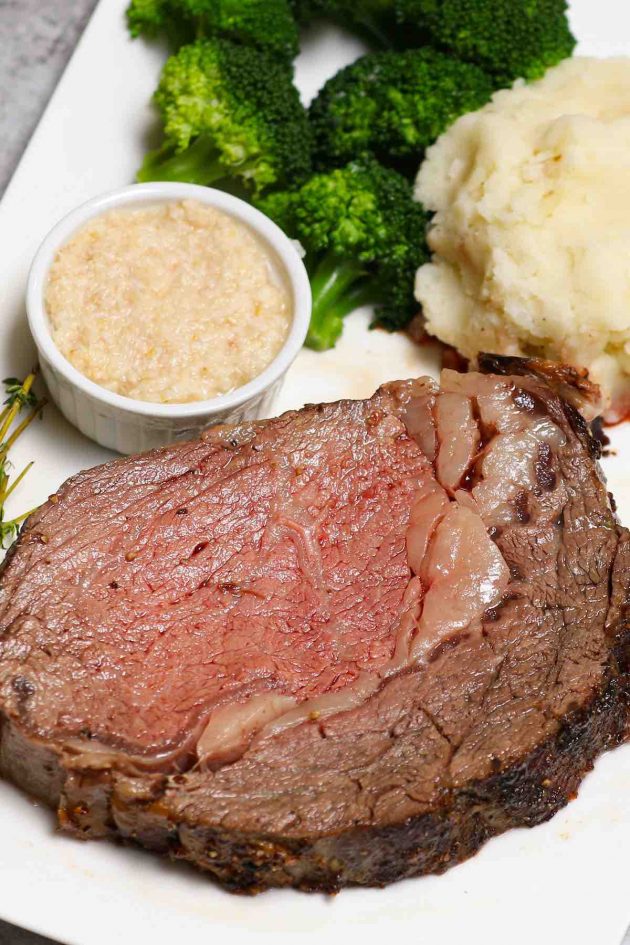
Boneless Prime Rib vs Bone In
Bone-in and boneless prime rib are both cut from the rib area, the same section ribeye steak comes from. While the bone-in or standing rib roast is more common, there are some distinctive advantages of going boneless:
- Cost: You're not paying for the weight of bones you can't eat!
- Cooking Time: Boneless cooks up in less time than the equivalent bone-in.
- Carving and Serving: There are no cumbersome bones to work around on the carving board or guests plates.
Yes, the roast is slightly smaller in size and less dramatic looking than a bone-in. Purists also claim that meat off the bone is better. However, I can hardly tell the difference on this exquisite cut!
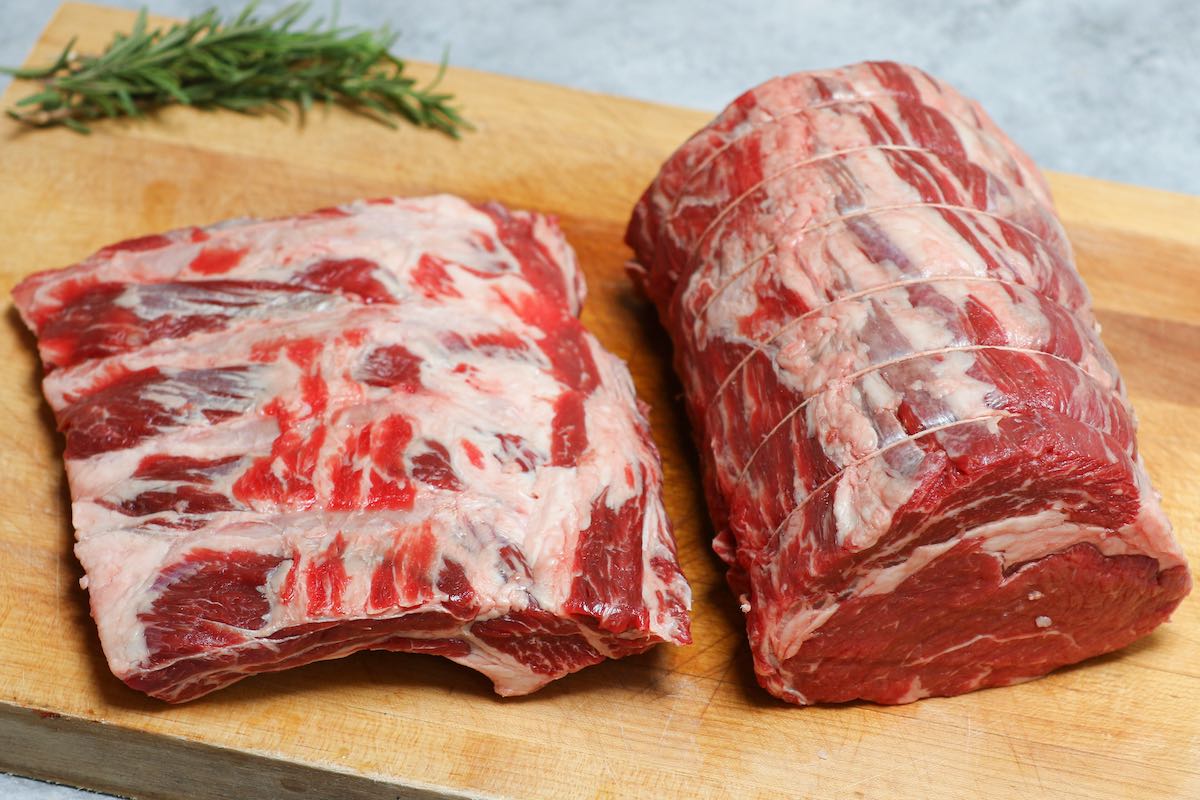
How to Buy a Boneless Rib Roast
Prime rib is one of the most expensive cuts of beef with prices often surpassing $10 per pound. The highest grade is Prime, which has the most marbling and therefore the best tenderness and flavor. Choice is the middle grade and can still be very good. Select is a low grade that is leaner and not recommended. Budget-permitting ask your butcher for Prime beef , which you can identify it by the ribbons of cream-colored fat that run throughout the meat.
Each steer produces two whole rib roasts spanning ribs #6-12 and weighing 14-20 pounds each. The most tender section is called the first cut and comes from ribs #10-12 at the loin end, with the rest coming from the chuck end. Ask for the first cut unless you need a very large roast.
If price is no barrier, you can also consider buying dry aged beef. The meat is aged for 18-30 days to produce an even greater level of tenderness and distinctive flavor.
How Big a Roast Do I Need?
The rule of thumb is ¾ – 1 pound per person for prime rib, but for a boneless rib roast you only need ½ – ¾ pound per person. Follow the table below to size your roast:
| Boneless Rib Roast Weight | Servings |
| 3 pounds | 4 – 6 people |
| 4 pounds | 6 – 8 people |
| 5 pounds | 7 – 10 people |
| 6 pounds | 8 – 12 people |
| 8 pounds | 11 – 16 people |
| 12 pounds | 16 – 24 people |
Target the higher number of servings for a buffet or when you'll have more side dishes, and the lower number of servings for a more substantial main course or larger appetites. Also note that the roast will shrink in size 15-20% by the time it has finished cooking.
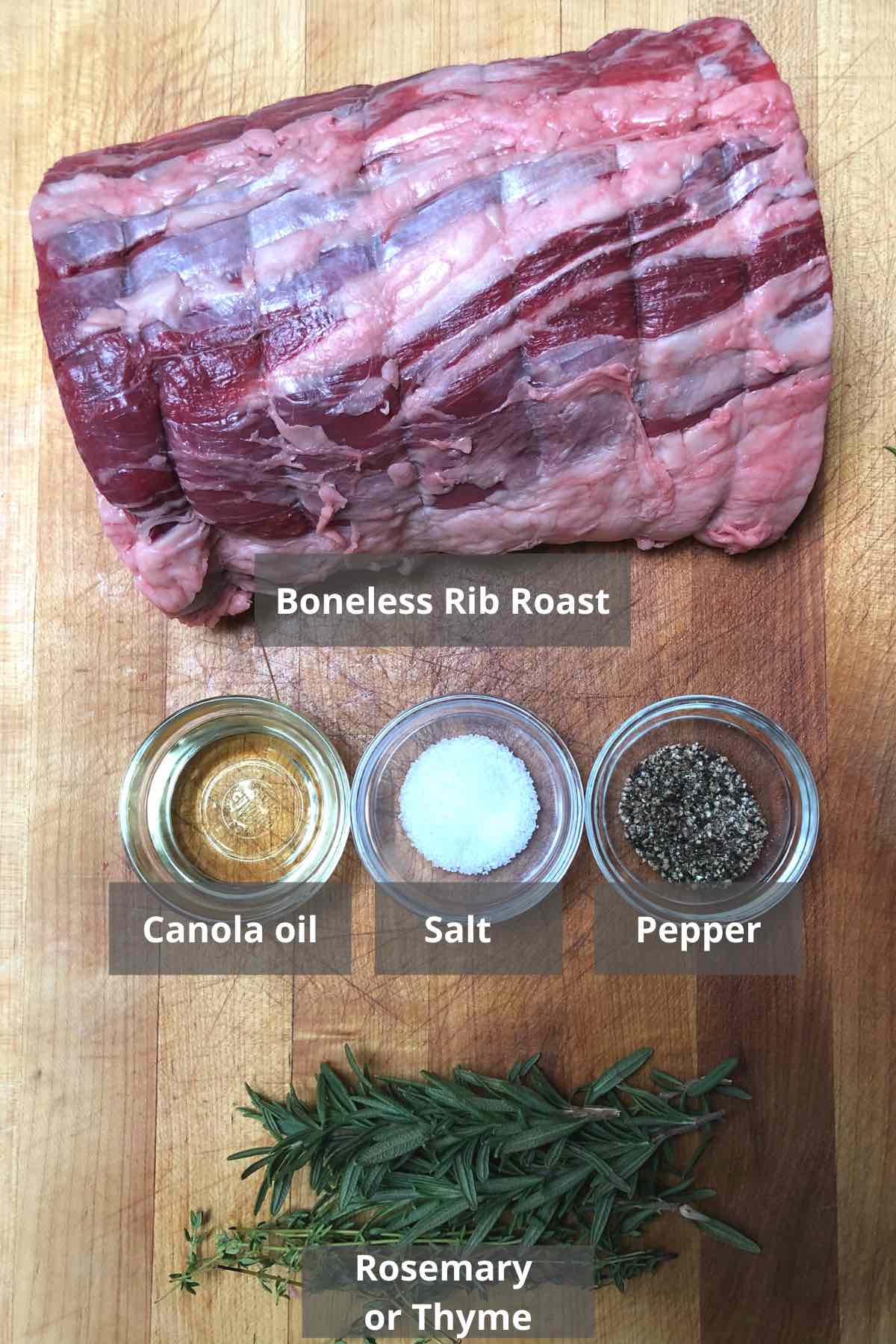
How to Cook a Boneless Prime Rib Roast
For this boneless prime rib recipe, you only need high-temperature oil (canola, sunflower etc), coarse salt, black pepper and optional seasonings like rosemary and thyme.
Start by removing the meat from the refrigerator 1-2 hours before cooking. This important step takes the chill off so the meat, helping it to cook faster and more evenly for juicier meat.
When you're ready to start roasting, prepare the meat. Pat dry with paper towels to remove excess moisture. Score the fat on the outside by running a sharp knife 1/8-inch in a diamond pattern. Then rub with oil, salt, pepper and seasonings. Put the roast fat-side up in a roasting pan fitted with a rack or trivet for air circulation.
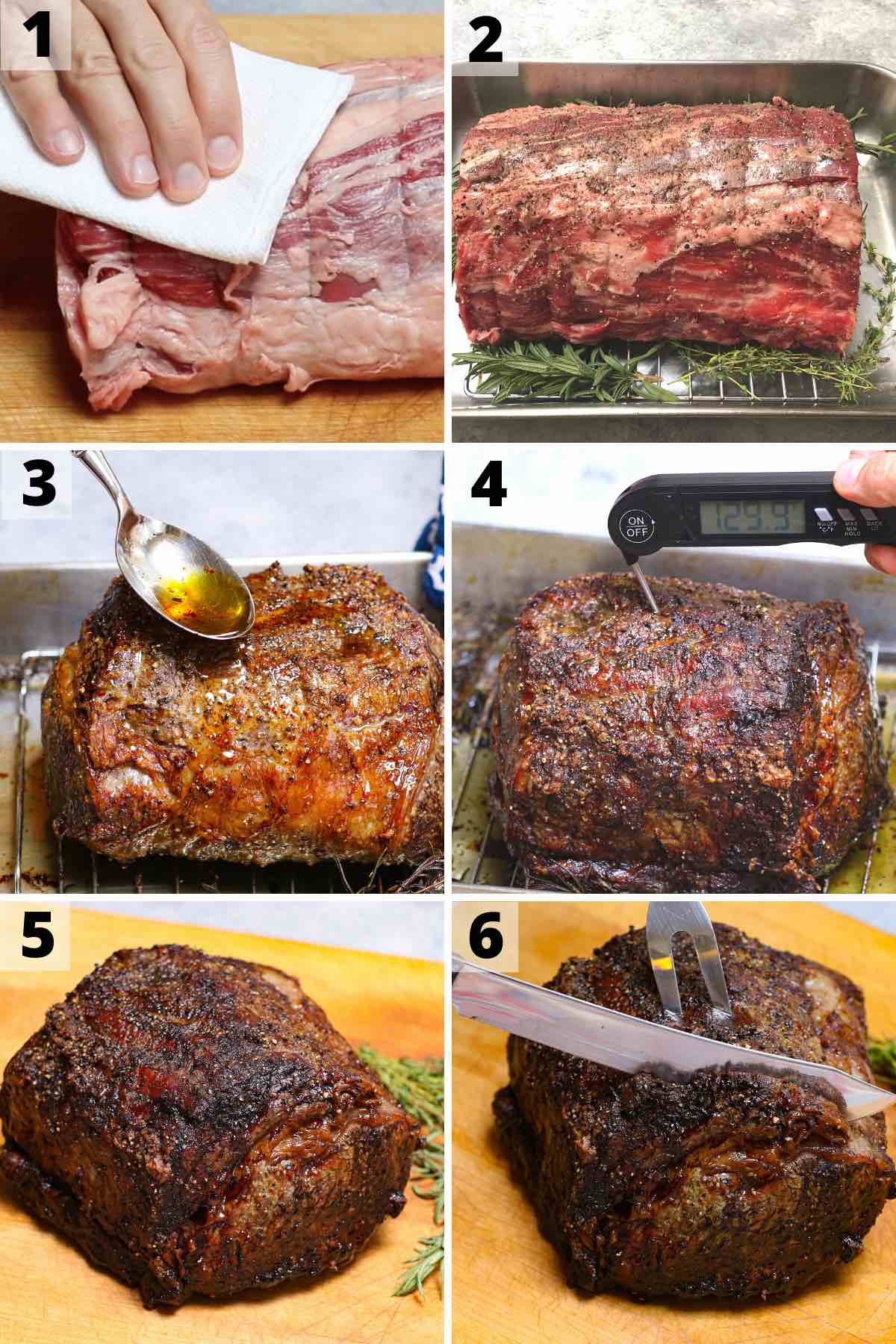
Next, place it uncovered in a 450°F oven to sear for 10 minutes. Then reduce the heat to 325°F, turning on your oven's convection or forced air if available.
Every hour or so, baste the meat by spooning or bulb-basting juices from the pan onto the meat. This step helps to keep the meat moist while adding flavor. If it starts turning dark brown quickly, cover loosely with aluminum foil.
When it's done, transfer the meat to a carving board and tent with foil. Let it rest for at least 15 minutes to allow the juices to redistribute through the meat. Then carve widthwise into slabs to serve.
How Long to Cook a Boneless Rib Roast
This is the million dollar question to avoid overcooking for this expensive cut of meat! The general rule for prime rib is 15 minutes per pound for medium-rare, but a boneless rib roast typically cooks faster at 12-14 minutes per pound assuming room-temperature meat (and slightly longer for a chilled roast).
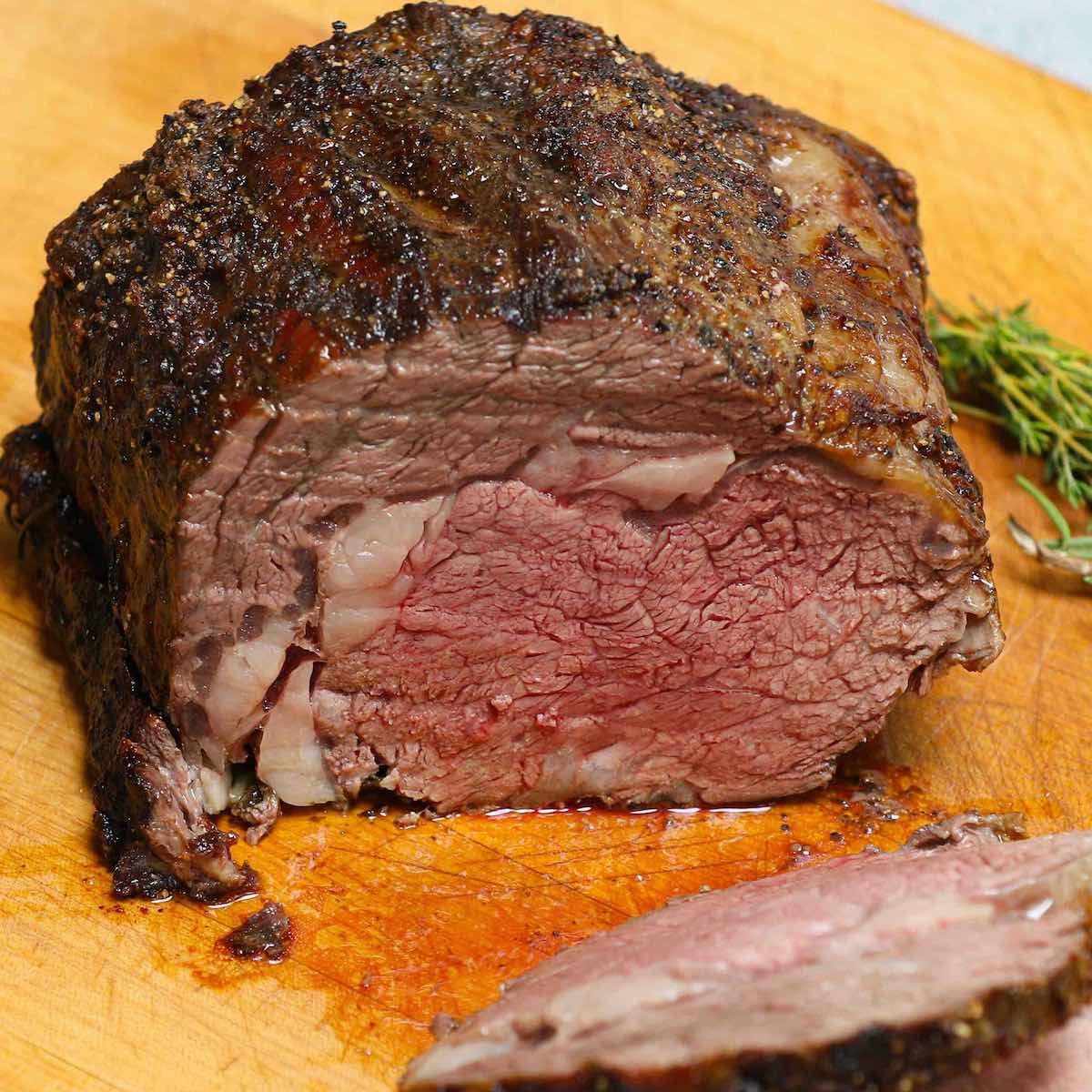
The only true way to nail the perfect doneness is by measuring the internal temperature of the meat using an instant-read thermometer as needed or with a wireless thermometer for continuous monitoring. Use the following chart for guidance:
| Doneness | Description | Internal Temp (In Oven / After Resting) |
| Rare | Cool red center | 115°F / 125°F |
| Medium rare | Warm red center | 125°F / 135°F |
| Medium | Warm pink center | 135°F / 145°F |
| Medium well | Slightly pink center | 140°F / 150°F |
| Well done | Little or no pink | 145°F / 155°F |
According to the USDA, the safe level for beef is a final temperature of 145°F followed by 3 minutes of resting.
When carving, give edge pieces to guests who prefer their meat more done, and the middle to those who prefer more red.
Serving Ideas
A boneless rib roast goes with so many sides dishes. Here some possibilities:
- Starch: boiled potatoes, baked potatoes, mashed potatoes or rice are classic sides. A more adventurous option is Yorkshire pudding, which you can bake alongside in a muffin pan.
- Vegetables: steamed broccoli, green beans or Brussels sprouts. Other veggie options include sautéed mushrooms, roasted parsnips, carrots or squash!
- Condiments: You can easily make your own au jus by pouring the pan drippings through a strainer into a saucepan and whisking in a few tablespoons of flour over medium heat to thicken. Creamy horseradish is a popular option too!
More Beef Roasts
- Sirloin Tip Roast
- Top Round Roast
- Eye of Round Roast
View all beef recipes
Boneless Prime Rib Roast
Boneless prime rib that's slow-roasted in the oven for tender and juicy beef that melts in your mouth. This boneless rib roast is the perfect way to celebrate the holidays or another festive occasion!
- 1 boneless prime rib roast, Prime grade and first cut recommended (see note)
- 1 tablespoons canola oil, see note
- 1 tablespoon coarse salt, kosher salt or sea salt
- 1 tablepsoon black pepper, freshly ground
- fresh sprigs rosemary or thyme, for garnish
-
Remove the roast from the refrigerator 1-2 hours ahead of time.
-
Preheat the oven to 450°F, placing the oven rack in the middle position and turning on the convection/forced air (if available).
-
While you're waiting, prepare the meat. Pat it dry with paper towels to remove excess moisture. Then score the fat on the outside about 1/8-inch deep using a sharp knife in a diamond pattern with the cuts spaced an inch or so apart.
-
Rub the meat on all sides with the oil, followed by the salt and pepper. Place it fat-side up in a roasting pan fitted with a wire rack. Scatter the optional fresh herbs around the roast, reserving some for serving. If you're using a thermometer, insert the probe into the middle of the meat.
-
Place the meat in the oven and roast for 10 minutes. Then reduce the heat to 325°F. Every 30-60 minutes, baste the meat by spooning of bulb-basting the pan juices onto the meat. If the meat gets dark brown before the final 30 minutes, cover loosely with aluminum foil.
-
After 60-90 minutes (or longer for large roasts), start checking the internal temperature of the meat. Insert the probe of an instant-read thermometer into the center of the roast: 115°F is rare, 125°F is medium-rare, 135°F is medium, 140°F is medium-well and 145°F is well-done. Note that temperatures will typically rise another 10°F from these levels out of the oven.
-
When your desired doneness is reached, remove the roast to a carving board and tent with foil. Let it rest undisturbed for 15-20 minutes to allow the juices to redistribute throughout the meat.
-
Slice against the grain to serve. Note that the outside edges will be more cooked and the center sections more red, so you can distribute servings to guests accordingly.
- Beef: When shopping, look for well-marbled beef that is prime or select grade, and ideally the smaller first cut from the loin end. Buy ½ – ¾ pound per person depending on appetites.
- Oil: Use a high-temperature oil that will not smoke in the oven. Options include canola, sunflower, safflower and refined olive oil. Avoid extra virgin olive oil.
- Gravy: To make gravy, pour the pan drippings into a medium saucepan over medium-high heat. Remove excess fat so there's only 1/4 cup fat plus brown bits and juices (a fat separator is helpful for this). Once the fat bubbles, whisk in 1/4 cup flour and let it bubble for 30 second. Then dribble in 3 or 4 cups of milk, broth or water, whisking continuously until thick enough to coat the back of a spoon. Taste and season with salt and pepper.
Nutrition Facts
Boneless Prime Rib Roast
Amount Per Serving (8 oz)
Calories 853 Calories from Fat 684
% Daily Value*
Fat 76g 117%
Saturated Fat 32g 160%
Cholesterol 171mg 57%
Sodium 562mg 23%
Potassium 626mg 18%
Carbohydrates 1g 0%
Fiber 1g 4%
Sugar 1g 1%
Protein 38g 76%
Calcium 21mg 2%
Iron 4mg 22%
* Percent Daily Values are based on a 2000 calorie diet.
Please read our nutrition disclaimer.
Did you make this recipe? Leave a comment below!
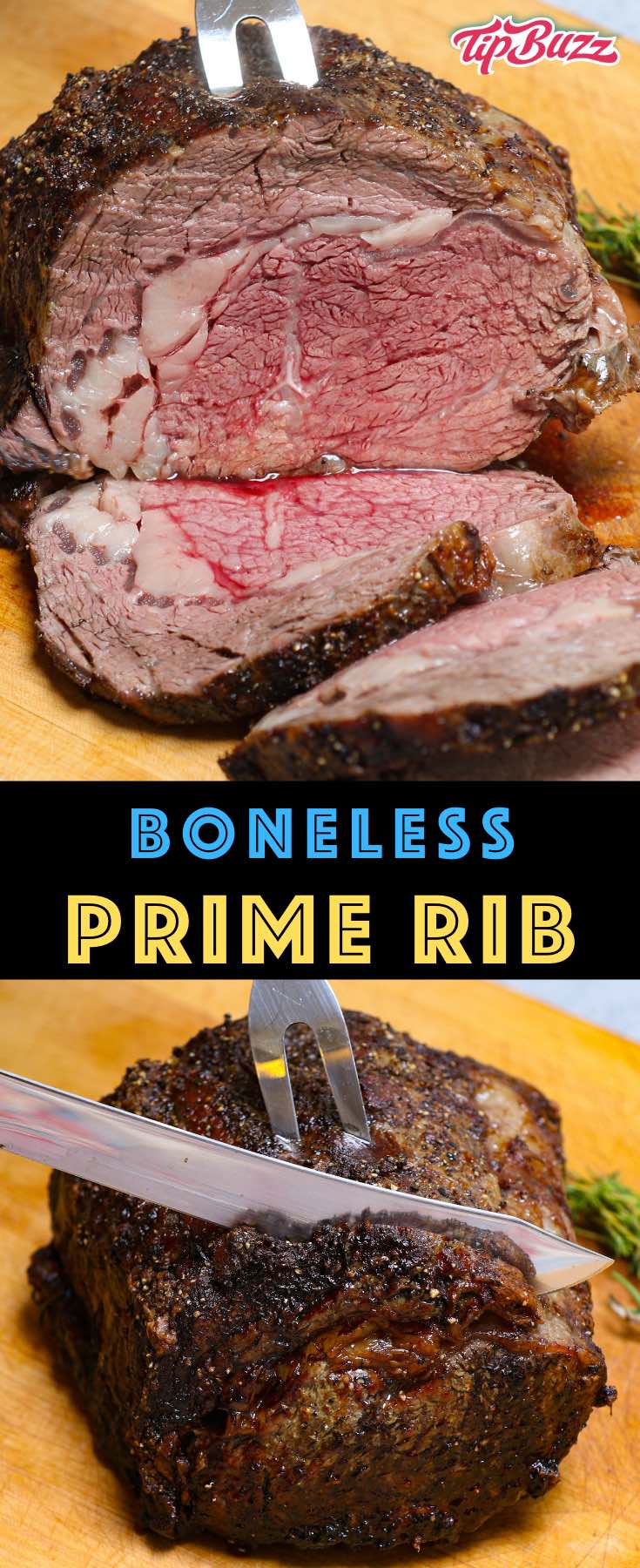
© TIPBUZZ. Images and text on this website are copyright protected. Please do not post or republish without permission. If you want to republish this recipe, please link back to this post. This post may contain affiliate links. Read the disclosure policy here.
Source: https://tipbuzz.com/boneless-rib-roast/
0 Response to "Cooking Time Bone in Vs Boneless Roast Beef"
Post a Comment